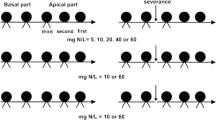Summary
The costs and benefits, measured in terms of dry weight, of physiological integration between clonal ramets, were analysed in two experiments conducted on the clonal herb Glechoma hederacea. Firstly, integration between consecutively-produced ramets was examined in an experiment in which stolons grew from one set of growing conditions (either unshaded or shaded and either nutrient-rich or nutrient-poor) into conditions in which light or nutrient level was altered. Comparisons were made between the dry weight of the parts of the clones produced before and after growing conditions were changed, and the dry weights of the corresponding part of control clones subjected to constant growing conditions. In a second experiment, integration between two distinct parts of G. hederacea clones was investigated. In this experiment clones were grown from two connected parent ramets and the parts of the clone produced by each parent ramet were subjected independently to either nutrient-rich or nutrient-poor conditions. Ramets in resource-rich conditions provided considerable physiological support to those in resource-poor conditions. This was measured as a dry weight gain compared with the weight of the corresponding part of the control clones growing in resource-poor conditions. However, when stolons grew from resource-poor conditions into resource-rich conditions, there was no similar evidence of the resourcepoor ramtes receiving support from resource-rich ramets. Physiological integration did not result in dry weight gains when this would have necessitated basipetal translocation of resources.Because of the predominantly acropedal direction of movement of translocates in G. hederacea, the structure of the clone was important in determining the effectiveness of integration between ramets. Where physiological integration was effective, the cost to the supporting ramets in terms of dry weight was insignificant. Physiological integration allows clones to maintain a presence in less favourable sites with insignificant cost to ramets in favourable sites, thereby reducing the probability of invasion by other plants, and providing the potential for rapid clonal growth if conditions improve. Integrated support of ramets in unfavourable conditions also enables the clone to grow through unfavourable sites, thus increasing the probability of encountering more favourable conditions by wider foraging.
Similar content being viewed by others
References
Allessio ML, Tieszen LL (1975) Patterns of carbon allocation in an arctic tundra grass, Dupontia fischeri (Gramineae) at Barrow, Alaska. Amer J Bot 62:797–807
Alpert P, Mooney HA (1986) Resource sharing among ramets in the clonal herb Fragaria chiloensis. Oecologia (Berlin) 70:227–233
Ashmun JW, Thomas RJ, Pitelka LF (1982) Translocation of photoassimilates between sister ramets in two rhizomatous forest herbs. Ann Bot49:403–415
Gifford RM, Marshall C (1973) Photosynthesis and assimilate distribution in Lolium multiflorum Lam. following differential tiller defoliation. Aust J Biol Sci26:517–526
Ginzo HD, Lovell PH (1973a) Aspects of the comparative physiology of Ranunculus bulbosus L. and Ranunculus repens L. I. Response to nitrogen. Ann Bot 37:753–764
Ginzo HD, Lovell PH (1973b) Aspects of the comparative physiology of Ranunculus bulbosus L. and Ranunculus repens L. II. Carbon dioxide assimilation and distribution of photosynthates. Ann Bot 37:765–776
Grime JP (1979) Plant Strategies and Vegetation Processes. John Wiley & Sons, Chichester
Grindey E (1975) Ecological aspects of the runnering habit of plants with special reference to mineral nutrition. Ph.D. thesis, University of Sheffield
Guttridge CB (1959) Evidence of a flower inhibitor and growth promoter in the strawberry. Ann Bot 23:351–360
Hartnett DC, Bazzaz FA (1983) Physiological integration among intraclonal ramets in Solidago canadensis. Ecology 64:779–788
Hartnett DC, Bazzaz FA (1985a) The genet and ramet population dynamics of Solidago canadensis in an abanoned field.J Ecol 73:407–414
Hartnett DC, Bazzaz FA(1985b) The integration of neighbourbood effects by clonal genets of Solidago canadensis.J Ecol 73:415–428
Hoshino M (1972) Translocation and accumulation of assimilates in forage plants. Jap Agr Res Quart 6:165–168
Newell SJ (1982) Translocation of 14C-photoassimilate in two stoloniferous Viola species. Bull Torrey Bot Club109:306–317
Noble JC (1976) The population biology of rhizomatous plants. Ph.D. thesis, University of Wales
Noble JC, Marshall C (1983) The population biology of plants with clonal growth. II. The nutrient strategy and modular physiology of Carex arenaria. J Ecol 71:865–877
Norton RA, Wittwer SW (1962) Foliar and root absorption and distribution of phosphorus and calcium in the strawberry. Proc Amer Soc Hort Sci 82:277–286
Salzman AG, Parker MA (1985) Neighbours ameliorate local salinity stress for a rhizomatous plant in a heterogeneous environment. Oecologia (Berlin) 65:273–277
Slade AJ, Hutchings MJ (1987a) The effects of nutrient availability on foraging in the clonal herb Glechoma hederacea. J Ecol 75:95–112
Slade AJ, Hutchings MJ (1987b) The effects of light intensity on foraging in the clonal herb Glechoma hederacea. J Ecol 75:(in press)
Slade AJ, Hutchings MJ (1987c) Clonal integration and plasticity in foraging behaviour in Glechoma hederacea. J Ecol 75:(in press)
Tietema T (1980) Ecophysiology of the sand sedgeCarex arenaria. II. The distribution of 14C assimilates. Acta Bot Neerl 29:165–178
Turkington R, Harper JL (1979) The growth, distribution and neighbour relations of Trifolium repens in a permanent pasture. II. Inter-and intra-specific contact. J Ecol 67:219–230
Author information
Authors and Affiliations
Rights and permissions
About this article
Cite this article
Slade, A.J., Hutchings, M.J. An analysis of the costs and benefits of physiological integration between ramets in the clonal perennial herb Glechoma hederacea . Oecologia 73, 425–431 (1987). https://doi.org/10.1007/BF00385260
Received:
Issue Date:
DOI: https://doi.org/10.1007/BF00385260




